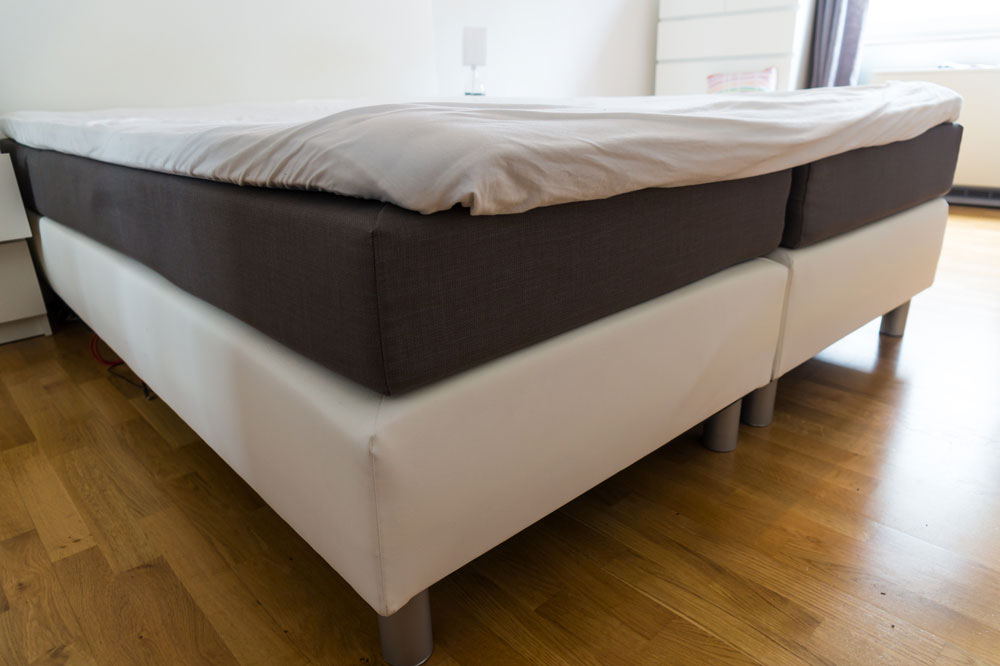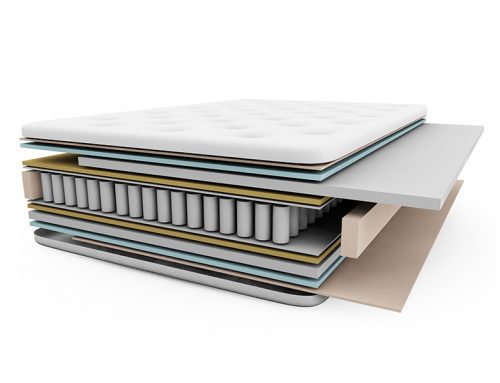Here it is—everything you didn’t know you needed to know about boxsprings, platform beds, and how they stack up against each other!
Platform beds defined
A platform bed is a bed constructed with a self-contained base for your mattress. Technically, if your bed lets you place your mattress directly onto your frame, then what you’re looking at is a platform bed.
Most of the time, platform beds create this foundation through wooden slates, arranged in rows—although latticing is another popular option. By using wood, slats provide a level of rigidity to provide firmness and durability under a mattress. At the same time, most slats are manufactured to bow outwards from the middle of the bed, which adds flexibility and give to the bed.
Many platform beds also come complete with headboards, footboards, under-bed storage, or even built-in side tables. Whatever the design, however, a platform bed will likely be lower than any frame with box springs, with most ranging between five inches and a foot in height.
Today, platform beds have made somewhat of a comeback thanks to a rise in new online mattress delivery companies, which offer 100% foam constructed mattresses and recommend platform bases for their product.
Boxsprings defined
Box springs are, for the most part, literally as they sound: a wooden box containing metal springs. Also known as a divan in some countries, box springs are the traditional base for mattresses.
While not all of today’s box springs are made from wood, and while some contain more modern alternatives to springs, they essentially carry out the same function as they’ve always done—enhancing the give and softness in your mattress, while also helping to absorb and isolate movements.
Because they are covered in fabric and allow air to pass through them, box springs are also intended to disperse heat from your bed. And finally, many box springs are manufactured by mattress brands to accompany particular mattresses, with the springs lining up in each part of the bed set up, promoting maximum support.
Is mattress-compatibility a factor?
A large part of your decision-making when it comes to platform vs box spring will be based on the kind of mattress you already have.
Most mattress manufacturers and bed specialists are happy for any mattress to be used directly on a platform bed, without any further foundation. This is especially the case for memory foam mattresses, which benefit from the firmness that platform beds provide.
In fact, most bed experts advise against using box springs with any mattress composed of foam, as it’s thought that springs in a boxspring can focus pressure on certain parts of the bed. Many of the newer foam mattress brands explicitly don’t recommend box springs—take this piece from popular brand Leesa, for example, or these recommendations from Casper.
As for box springs and mattresses, they’re often designed to pair specifically with a certain spring mattress. So in those cases, a box spring is the obvious choice. Basically, it’s all about providing a solid foundation for your mattress, as this HuffPost article describes. So the question is less, does my mattress go with a box spring? and more, will a box spring help provide a better mattress foundation?

How do they stack up against each other?
The mattress nerd points out that a major benefit of box springs is the way they raise the mattress higher off the ground, which can be aesthetically pleasing, or a real necessity for those with mobility issues.
A box spring is also lighter than a platform bed, making it more portable, but also more subject to wear and tear. If your box spring is made of real springs, those springs will also lose springiness over time.
A platform bed is far more durable in these areas, given its solid construction. Using a platform is also simpler—it eliminates the need for costly extras such as a box spring, under bed storage, and so on.
Is it an either/or decision?
Actually, you can have both. If you have a platform bed and are looking for a little more height or softness, you should be able to add a box spring into the mix.
Depending on the specific type of platform, adding a boxspring may require a few small modifications. To keep the box spring in place, for example, you might need to add a strap or a frame. Many platform beds will come box spring-ready, however. Most can be adjusted to different heights to accommodate another layer in your mattress foundation.
Summary
Boxsprings are the classic choice for a bed foundation, but they do originate from a time when mattresses didn’t shape up. Today, most mattresses don’t require a box spring unless they’re specifically paired with one. If you’re still unsure whether to get a box spring, this guide may help inform your decision.
Platform beds, compatible with all mattress types, are a good option if you don’t mind a lower profile. They’re often a more affordable choice, and are recommended by many of the newer, foam-based online mattress brands.





